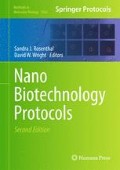Abstract
Nanoparticles possess unique properties that are enhanced due to their small size and varied shapes. These properties can be directly manipulated by controlling the aggregation state, which can further be exploited for applications in bio/chemical sensing, plasmonics, and as supports for catalysts. While the advantages of controlled aggregates of nanomaterials are great, synthetic strategies to achieve such structures with precision over the final arrangement of the materials in three-dimensional space remain limited. We have shown that ligand exchange reactions on Au nanomaterials of various shapes using simple amino acids can induce the formation of linear aggregates of the materials. The assembly process is mediated by partial ligand exchange on the particle surface, followed by the surface segregation of the two ligands that produces an electric dipole across the nanomaterial from which alignment occurs in solution via dipole–dipole interactions. This linear-based assembly can be used to tune the optical properties of the materials and could represent new pathways to study the interactions between biological molecules and inorganic nanomaterials.
Access this chapter
Tax calculation will be finalised at checkout
Purchases are for personal use only
References
Jain PK, Eustis S, El-Sayed MA (2006) Plasmon coupling in nanorod assemblies: optical absorption, discrete dipole approximation simulation, and exciton-coupling model. J Phys Chem B 110:18243
Jain PK, Huang X, El-Sayed IH, El-Sayed MA (2008) Noble metals on the nanoscale: optical and photothermal properties and some applications in imaging, sensing, biology, and medicine. Acc Chem Res 41:1578
Rosi NL, Giljohann DA, Thaxton CS, Lytton-Jean AKR, Han MS, Mirkin CA (2006) Oligonucleotide-modified gold nanoparticles for intracellular gene regulation. Science 312:1027
Daniel M-C, Astruc D (2004) Gold nanoparticles: assembly, supramolecular chemistry, quantum-size-related properties, and applications toward biology, catalysis, and nanotechnology. Chem Rev 104:293
Murphy CJ, Gole AM, Hunyadi SE, Stone JW, Sisco PN, Alkilany A, Kinard BE, Hankins P (2008) Chemical sensing and imaging with metallic nanorods. Chem Commun 544
Templeton AC, Wuelfing WP, Murray RW (2000) Monolayer-protected cluster molecules. Acc Chem Res 33:27
Rosi NL, Mirkin CA (2005) Nanostructures in biodiagnostics. Chem Rev 105:1547
Slocik JM, Naik RR (1988) Biologically programmed synthesis of bimetallic nanostructures. Adv Mater 2006:18
Pacardo DB, Sethi M, Jones SE, Naik RR, Knecht MR (2009) Biomimetic synthesis of Pd nanocatalysts for the stille coupling reaction. ACS Nano 3:1288
Slocik JM, Govorov AO, Naik RR (2008) Photoactivated biotemplated nanoparticles as an enzyme mimic. Angew Chem Int Ed 47:5335
Slocik JM, Zabinsky JS, Phillips DM, Naik RR (2008) Colorimetric response of peptide-functionalized gold nanoparticles to metal ions. Small 4:548
Knecht MR, Sethi M (2009) Bio-inspired colorimetric detection of Hg2+ and Pb2+ heavy metal ions using Au nanoparticles. Anal Bioanal Chem 394:33
Nam KT, Kim D-W, Yoo PJ, Chiang C-Y, Meethong N, Hammond PT, Chiang Y-M, Belcher AM (2006) Virus-enabled synthesis and assembly of nanowires for lithium ion battery electrodes. Science 312:885
Huo F, Lytton-Jean AKR, Mirkin CA (2006) Asymmetric functionalization of nanoparticles based on thermally addressable DNA interconnects. Adv Mater 18:2304
Xu X, Rosi NL, Wang Y, Huo F, Mirkin CA (2006) Asymmetric functionalization of gold nanoparticles with oligonucleotides. J Am Chem Soc 128:9286
Sethi M, Joung G, Knecht MR (2009) Linear assembly of Au nanorods using biomimetic ligands. Langmuir 25:1572
Sethi M, Knecht MR (2009) Experimental studies on the interactions between Au nanoparticles and amino acids: bio-based formation of branched linear chains. ACS Appl Mater Interfaces 1:1270
Sethi M, Knecht MR (2010) Understanding the mechanism of amino acid-based Au nanoparticle chain formulation. Langmuir 26:9860
Caswell KK, Wilson JN, Bunz UHF, Murphy CJ (2003) Preferential end-to-end assembly of gold nanorods by biotin-streptavidin connectors. J Am Chem Soc 125:13914
Sau TK, Murphy CJ (2004) Seeded high yield synthesis of short Au nanorods in aqueous solution. Langmuir 20:6414
Lee J-S, Stoeva SI, Mirkin CA (2006) DNA-induced size-selective separation of mixtures of gold nanoparticles. J Am Chem Soc 128:8899
Smith DK, Korgel BA (2008) The importance of the CTAB surfactant on the colloidal seed-mediated synthesis of gold nanorods. Langmuir 24:644
Smith DK, Miller NR, Korgel BA (2009) Iodide in CTAB prevents gold nanorod formation. Langmuir 25:9518
Sethi M, Joung G, Knecht MR (2009) Stability and electrostatic assembly of Au nanorods for use in biological assays. Langmuir 25:317
Acknowledgments
We are grateful to the National Science Foundation, American Chemical Society—Petroleum Research Fund, and the University of Kentucky for financial support. The authors also wish to acknowledge the UK Electron Microscopy Center for assistance with the TEM analysis and Dr. T. Dziubla, UK Department of Chemical and Materials Engineering, for assistance with the DLS analysis. M.S. acknowledges student financial support from the Research Challenge Trust Fund and the University of Kentucky Presidential Fellowship.
Author information
Authors and Affiliations
Editor information
Editors and Affiliations
Rights and permissions
Copyright information
© 2013 Springer Science+Business Media New York
About this protocol
Cite this protocol
Sethi, M., Knecht, M.R. (2013). Amino Acid Mediated Linear Assembly of Au Nanomaterials. In: Rosenthal, S., Wright, D. (eds) NanoBiotechnology Protocols. Methods in Molecular Biology, vol 1026. Humana Press, Totowa, NJ. https://doi.org/10.1007/978-1-62703-468-5_12
Download citation
DOI: https://doi.org/10.1007/978-1-62703-468-5_12
Published:
Publisher Name: Humana Press, Totowa, NJ
Print ISBN: 978-1-62703-467-8
Online ISBN: 978-1-62703-468-5
eBook Packages: Springer Protocols

